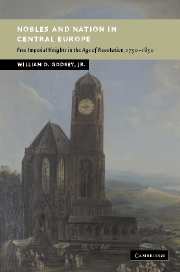Book contents
- Frontmatter
- Contents
- Preface
- Abbreviations
- Introduction
- 1 Wealth and noble autonomy: the Free Imperial Knights in Mainz on the eve of revolution
- 2 Nobles becoming Germans: the transformation of a concept
- 3 Nobles becoming Germans: the destruction of a “geo-cultural landscape”
- 4 Between destruction and survival: knights on the Middle Rhine 1750–1850
- 5 The past recaptured: knights in the Hapsburg Empire 1792–1848
- 6 From cathedral canons to priests: the Coudenhoves and the “Catholic revival”
- 7 The beginnings of conservative German nationalism: the “naturalization” of Baron Carl vom und zum Stein (1757–1831)
- Conclusion
- Appendix: Families of Free Imperial Knights (1797)
- Bibliography
- Index
Preface
Published online by Cambridge University Press: 01 October 2009
- Frontmatter
- Contents
- Preface
- Abbreviations
- Introduction
- 1 Wealth and noble autonomy: the Free Imperial Knights in Mainz on the eve of revolution
- 2 Nobles becoming Germans: the transformation of a concept
- 3 Nobles becoming Germans: the destruction of a “geo-cultural landscape”
- 4 Between destruction and survival: knights on the Middle Rhine 1750–1850
- 5 The past recaptured: knights in the Hapsburg Empire 1792–1848
- 6 From cathedral canons to priests: the Coudenhoves and the “Catholic revival”
- 7 The beginnings of conservative German nationalism: the “naturalization” of Baron Carl vom und zum Stein (1757–1831)
- Conclusion
- Appendix: Families of Free Imperial Knights (1797)
- Bibliography
- Index
Summary
The idea for this book on the Free Imperial Knights in Electoral Mainz goes back to a discussion with Ralph Melville in the late winter of 1996 at Mainz's Institute for European History, from whose windows the great Romanesque cathedral of St. Martin is visible. Later the same year, the idea was refined into a concrete proposal for a monograph and became part of a research project entitled, “Continuity or Revolutionary Break? Élites in Transition from the Old Regime to Modernity (1750–1850),” lavishly financed for more than a dozen fellows from 1996/97 to 2000 by the Institute for European History in Mainz with the support of the Gerda Henkel Foundation. I am grateful to the Institute and its director, Heinz Duchhardt, for the nearly four years of funding that enabled me to research a topic whose sources are so scattered throughout Central Europe. Of my former colleagues in Mainz, I should especially like to mention Frans Willem Lantink, who usually had the sharpest, and often the wittiest, perspective on Mainz and its cathedral canons and I am indebted to him for his perspective and suggestions.
A generous Lise-Meitner-Fellowship provided by the Fonds zur Förderung der wissenschaftlichen Forschung in Vienna enabled me to complete the first draft of the study. I am particularly obliged to Hannes Stekl of the Institute for Economic and Social History at the University of Vienna for his friendly support and hospitality during this stage of the work.
- Type
- Chapter
- Information
- Nobles and Nation in Central EuropeFree Imperial Knights in the Age of Revolution, 1750–1850, pp. ix - xPublisher: Cambridge University PressPrint publication year: 2004

